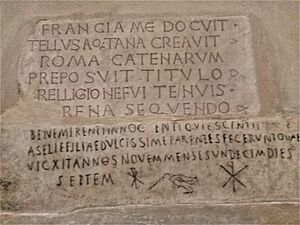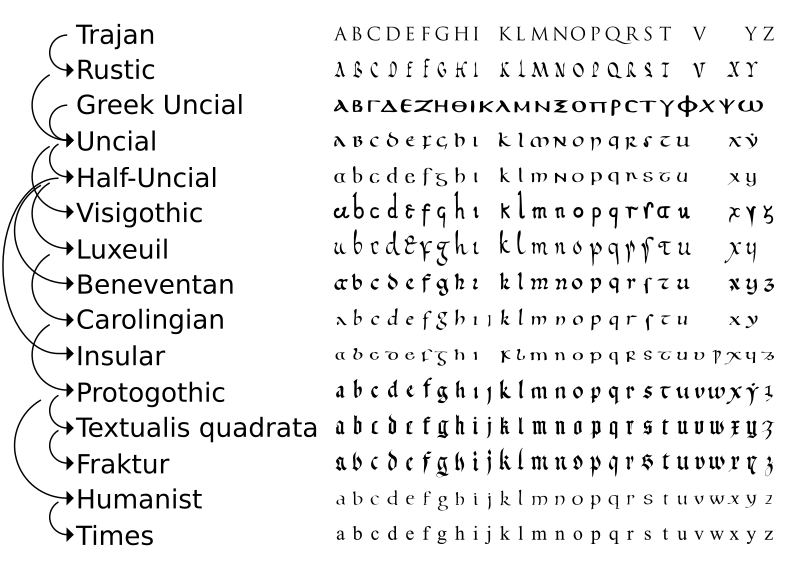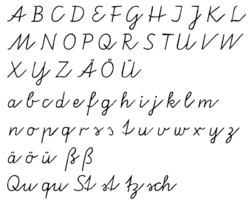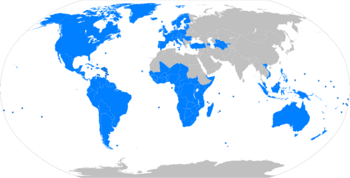History of the Latin script facts for kids
The Latin script is the most used writing system in the world. It's the main alphabet for English and many other languages. You might even call it "the alphabet"! It started in Italy around 700 BC and has changed a lot over 2,500 years.
The Latin alphabet came from older alphabets like the Phoenician, Greek, and Etruscan. Over time, some letter sounds changed. Some letters were added, and some were lost. Different writing styles also appeared. For example, small letters (minuscule) and capital letters (majuscule) were combined into one system. Today's capital letters are very similar to the ancient ones.
Contents
How the Latin Alphabet Changed Over Time
The Latin alphabet began with big, blocky capital letters called Roman square capitals. Smaller letters (lowercase) grew from faster, flowing writing styles. These styles were used when people wrote with a pen. Many different ways to write each letter appeared over the years.
For example, the letter G came from C. The letter J came from I. The letters U and V also split from each other. The letter W was created by joining two V's together. Some letters, like the old English letter thorn (Þ), were used for a while but then disappeared.
Thanks to a renewed interest in old Roman times, people brought back the clear, bold Roman capital letters. This made old Latin writings easy to read. However, many old books from the Middle Ages are hard to read today. This is because the letters look unfamiliar, words are often squished together, and many abbreviations were used.
The sounds of some letters have changed in modern languages. This is true for languages like Italian, English, Dutch, and French. Vowel sounds have also shifted a lot, especially in English and Portuguese. Sometimes, words that sound the same are spelled differently. Also, new letter combinations, called digraphs, were created for new sounds. For example, "sh" in English makes one sound.
Where the Latin Alphabet Came From
Most experts believe the Latins got their alphabet from the Etruscan alphabet. The Etruscans got their alphabet from a Greek colony in Italy called Cumae. This Greek alphabet was a Western version of the Greek alphabet. And the Greek alphabet itself came from the Phoenician alphabet. The Phoenician alphabet was inspired by Egyptian hieroglyphs.
The Latins eventually took 21 of the original 26 Etruscan letters.
An Old Story About the Alphabet
A Roman writer named Gaius Julius Hyginus wrote about a legend. He said that a goddess named Carmenta changed 15 letters of the Greek alphabet to create the Latin alphabet. Her son, Evander, then brought this alphabet to Italy. This story is not based on historical facts.
Here's what Hyginus wrote:
- The goddesses Parcae invented seven Greek letters: A, B, H, T, I, Y.
- Others say the god Mercury invented them by watching cranes fly. Cranes form letters when they fly.
- Palamedes invented eleven letters.
- Simonides invented four letters: O, E, Z, PH.
- Epicharmus invented two: P and PS.
- Mercury supposedly brought Greek letters to Egypt.
- Cadmus took them from Egypt to Greece.
- Cadmus, in exile, brought them to Italy.
- His mother Carmenta changed them into 15 Latin letters.
- The god Apollo added the rest.
From Egyptian Hieroglyphs to Latin Letters
The Latin alphabet has a long history, going all the way back to Egyptian hieroglyphs. Here's a table showing how some letters might have changed over time:
| Hieroglyph | Early Semitic | Sound | Old Name | Phoenician | Early Greek | Latin | ||||||
|---|---|---|---|---|---|---|---|---|---|---|---|---|
|
/ʔ/ | "ox" | A | |||||||||
|
/b/ | "house" | B | |||||||||
|
/g/ | "throwstick" | C G | |||||||||
|
/d/ | "fish" | D | |||||||||
|
/h/ | "praise" | E | |||||||||
|
/w/ | "fowl" | F | |||||||||
| U V W Y | ||||||||||||
|
/z/ | "sword" | Z | |||||||||
| /ð/ | "manacle" | |||||||||||
|
/ħ/ | "courtyard" | H | |||||||||
|
/x/ | "thread" | ||||||||||
|
/j/ | "hand" | I J | |||||||||
|
/k/ | "palm" | K | |||||||||
|
/l/ | "goad" | L | |||||||||
|
/m/ | "water" | M | |||||||||
|
/n/ | "snake" | N | |||||||||
|
/ʕ/ | "eye" | O | |||||||||
|
𓎛 |
/ɣ/ | "calyx" | |||||||||
|
/p/ | "corner" | P | |||||||||
|
/kˤ/ or /q/ | "needle/nape/monkey" | Q | |||||||||
|
/r/ | "head" | R | |||||||||
|
/ʃ/ | "sun" | S | |||||||||
|
/ɬ/ | "field, land" | ||||||||||
| /θ/ | "bow" | T | ||||||||||
|
/t/ | "mark" | ||||||||||
| N/A | X | |||||||||||
The Early Latin Alphabet
The very first Latin alphabet had these letters:
| A | B | C | D | E | F | Z | H | I | K | L | M | N | O | P | Q | R | S | T | V | X |
In the oldest Latin writings, the sounds for 'g' and 'k' were not clearly separated. They were both written using C, K, or Q. This is because the Etruscan language didn't have a clear difference between these sounds.
- K was used before A.
- Q was used before O or V.
- C was used everywhere else.
Later, the letter G was created to show the difference between the 'g' and 'k' sounds. G was simply a C with an extra line.
Letter Sounds in Early Latin
- C could sound like 'k' or 'g'.
- I could sound like 'i' (as in ski) or 'y' (as in yes).
- V could sound like 'oo' (as in moon) or 'w' (as in water).
Latin in the Old Roman Period
During this time, the letter K was used less often, and C became the main letter for both 'g' and 'k' sounds.
Around 300 BC, the letter Z was removed. A new letter, G, was put in its place. After this, C was used for the 'k' sound, and G was used for the 'g' sound.
Old Latin could be written from right to left, or in a style called boustrophedon (where lines switch direction). But after 100 BC, writing was almost always from left to right.
| A | B | C | D | E | F | G | H | I | K | L | M | N | O | P | Q | R | S | T | V | X |
Classical Latin Alphabet
The Roman emperor Claudius tried to add three new letters, but they didn't last long. After the Romans conquered Greece around 100 BC, they added the letters Y and Z from the Greek alphabet. These were placed at the end of the alphabet.
So, the new Latin alphabet had 23 letters:
| Letter | A | B | C | D | E | F | G | H | I | K | L | M | N | O | P | Q | R | S | T | V | X | Y | Z |
|---|
The Romans didn't use the old, traditional names for letters like the Greeks did. Instead, they used simpler names based on the letter's sound. Vowels were just their sound (like 'a' for A). For letters like B, C, D, they added an 'e' sound (like 'be' for B).
When Y was added, it was probably called hy like in Greek. But Romans found it hard to tell the difference between the 'i' and 'y' sounds. So, they called it i Graeca, meaning "Greek i". Z kept its Greek name, zeta.
Roman cursive was a common handwriting style. People used it for letters, business records, and schoolwork. Even emperors used it for quick messages. A more formal style used Roman square capitals. Roman cursive was popular from about 100 BC to 300 AD.
Latin in Late Roman Times
The Latin alphabet spread from Italy as the Roman Empire grew. It went to lands around the Mediterranean Sea. The eastern part of the Roman Empire mostly used Greek. But Latin was widely spoken in the western part. As new languages like French, Italian, Portuguese, and Spanish grew from Latin, they kept using and changing the Latin alphabet.
The Latin Alphabet in the Middle Ages
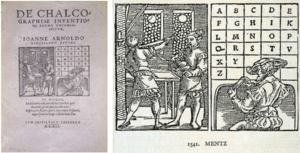
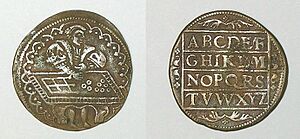
The small letters (lowercase) developed during the Middle Ages. They came from a writing style called New Roman Cursive. First, there was uncial script, then minuscule script. The old Roman capital letters were still used for important writings and for emphasis.
Languages that use the Latin alphabet usually capitalize the first letter of sentences and proper nouns (names of people, places, things). The rules for capitalization have changed over time. For example, in Old English, proper nouns were rarely capitalized. But in 18th-century English, many nouns were capitalized, much like in modern German.
Using the letters I and V for both vowel and consonant sounds became difficult. This was especially true as the Latin alphabet was used for Germanic and Romance languages.
- The letter W started as a double V (VV). It was used for the 'w' sound in Old English as early as the 7th century. It became common around the 11th century.
- In Romance languages, the small V looked like a rounded 'u'. From this, a rounded capital U was created for the vowel sound in the 16th century. A new, pointed small 'v' was then used for the consonant sound.
- For the letter I, a special ending shape, 'j', started to be used for the consonant sound. The plain 'i' was kept for the vowel sound. These rules were not always followed strictly for many years. J was added to English for the consonant sound in the 17th century. It wasn't fully seen as a separate letter until the 19th century.
The names of the letters mostly stayed the same, except for H. As the 'h' sound disappeared in Romance languages, the original Latin name hā sounded too much like A. So, people started using names like acca, which is where the English name aitch comes from.
Printing and Typefaces
When printing spread, different styles of Latin typography (the design of type) appeared. These styles were based on the lowercase letters from the Middle Ages. In Germany, printers like Johannes Gutenberg used blackletter styles. This tradition lasted until the 20th century.
In Italy, people became very interested in classical Roman culture again. So, the heavy gothic styles were replaced by Venetian Latin types, also called antiqua. These were based on the capital letters found on ancient Roman buildings.
However, scholars in the 15th century mistakenly thought Carolingian minuscule was the true Roman writing style. They redesigned the small Carolingian letters, making them taller and adding small lines (serifs). By the time movable type printing reached Italy, this humanistic writing had become a clear style called humanistic minuscule. This style became the basis for Venetian typefaces.
Handwriting Styles
Roman Cursive
Besides the blocky capital letters used in buildings, Romans also used Roman cursive for quick, everyday writing. They even had a type of shorthand called tironian notes.
Secretary Hand
While detailed textualis quadrata was used for religious books, a common handwriting style for everyday documents from the 13th century was secretary hand. This was a flowing script with unique, strong loops at the top and bottom of letters.
Italic Script
In the 16th and 17th centuries, secretary hand was slowly replaced by italic scripts. These were semi-flowing scripts. Early italic handwriting, from the 15th century, was based on humanist minuscule. It had clear serifs, a single-story 'a', an open-tailed 'g', and a slight forward slant. Later, it could have fancy loops and swirls.
This script also led to the italic type in printing. This is the slanted text you see used for emphasis or for titles of books.
Note: "Italic hand" (a writing style), "Italian hand" (a specific cursive style), and "Italic type" (a font style) are different things.
Copperplate and Cursive
After the 16th century, more flowing cursive styles developed from italic scripts. These are known as Copperplate script because of how calligraphy books were printed using copper plates. These styles were most popular in the 18th and 19th centuries.
Examples include the Italian hand and the English round-hand. These styles have flowing letters that could often be written without lifting the pen. Many countries developed their own cursive styles. Even though cursive writing is less common now, it is still taught in schools in some places.
How the Latin Alphabet Spread
As Western Christianity spread, the Latin alphabet went to people in northern Europe who spoke Germanic languages. It replaced their older Runic alphabets. It also spread to people speaking Baltic languages (like Lithuanian and Latvian) and some Uralic languages (like Hungarian, Finnish, and Estonian).
During the Middle Ages, the Latin alphabet was also adopted by people speaking West Slavic languages, such as Poles, Czechs, Croats, Slovenes, and Slovaks. This happened as they became Roman Catholic. People speaking East Slavic languages usually adopted Orthodox Christianity and the Cyrillic script.
By 1492, the Latin alphabet was mainly used in western, northern, and central Europe. Orthodox Christian Slavs in eastern and southeastern Europe mostly used the Cyrillic alphabet. Greek speakers still used the Greek alphabet. The Arabic alphabet was common in Islamic countries. Most of the rest of Asia used different alphabets or the Chinese script.
By the 18th century, the standard Latin alphabet had the 26 letters we use today. This was made possible by the rise of the printing press.
During the time of colonialism, the Latin alphabet spread worldwide. It was used for languages that had never been written down before, especially after Christianization and Bible translations. It spread to the Americas, Australia, and parts of Asia, Africa, and the Pacific. This happened along with the spread of Spanish, Portuguese, English, French, and Dutch languages.
In the late 18th century, Romanians adopted the Latin alphabet. Even though Romanian is a Romance language, Romanians were mostly Orthodox Christians. Until the 19th century, their church used the Romanian Cyrillic alphabet. Vietnam, under French rule, changed its language to use the Latin alphabet. Before that, Vietnamese used Chinese characters. The Latin alphabet is also used for many languages in Southeast Asia, like Tagalog, Malaysian, and Indonesian. It replaced older Arabic and Brahmic scripts there.
In 1928, as part of Kemal Atatürk's changes, Turkey started using the Latin alphabet for the Turkish language. This replaced the Arabic alphabet. Many Turkic-speaking people in the former Soviet Union also used the Latin alphabet in the 1930s. But in the 1940s, all those alphabets were changed to Cyrillic. After the Soviet Union broke apart in 1991, some of these countries, like Azerbaijan, Uzbekistan, and Turkmenistan, officially went back to using the Latin alphabet.
In the 1970s, China created an official way to write Mandarin Chinese using the Latin alphabet. It's called Pinyin. It helps children and foreigners learn how to say Chinese characters. However, Chinese characters are still used for reading and writing.
West Slavic languages and some South Slavic languages use the Latin alphabet instead of Cyrillic. This shows the main religion practiced by those people. For example, Polish uses many special marks and letter combinations. Croatian and the Latin version of Serbian also use special marks on letters. Languages of Eastern Orthodox Slavs usually use Cyrillic, which is more like the Greek alphabet. However, Serbian uses both alphabets.
See also
 In Spanish: Historia del alfabeto latino para niños
In Spanish: Historia del alfabeto latino para niños
- History of the alphabet
- Scribal abbreviation



